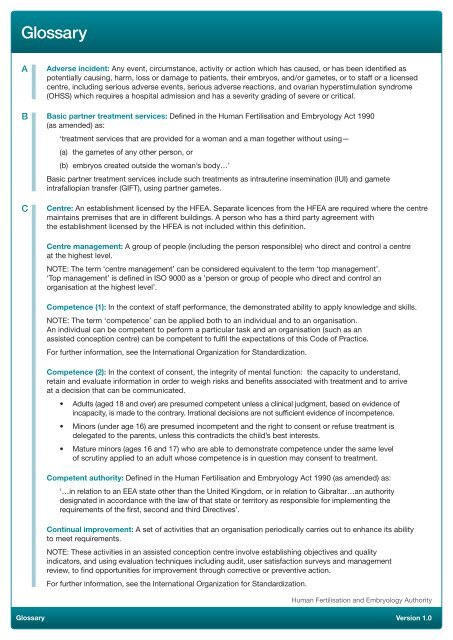Eighth Edition - R.3 - Human Fertilisation & Embryology Authority
Eighth Edition - R.3 - Human Fertilisation & Embryology Authority
Eighth Edition - R.3 - Human Fertilisation & Embryology Authority
You also want an ePaper? Increase the reach of your titles
YUMPU automatically turns print PDFs into web optimized ePapers that Google loves.
Glossary<br />
A<br />
Adverse incident: Any event, circumstance, activity or action which has caused, or has been identified as<br />
potentially causing, harm, loss or damage to patients, their embryos, and/or gametes, or to staff or a licensed<br />
centre, including serious adverse events, serious adverse reactions, and ovarian hyperstimulation syndrome<br />
(OHSS) which requires a hospital admission and has a severity grading of severe or critical.<br />
B Basic partner treatment services: Defined in the <strong>Human</strong> <strong>Fertilisation</strong> and <strong>Embryology</strong> Act 1990<br />
(as amended) as:<br />
‘treatment services that are provided for a woman and a man together without using—<br />
(a)<br />
(b)<br />
the gametes of any other person, or<br />
embryos created outside the woman’s body…’<br />
Basic partner treatment services include such treatments as intrauterine insemination (IUI) and gamete<br />
intrafallopian transfer (GIFT), using partner gametes.<br />
C<br />
Centre: An establishment licensed by the HFEA. Separate licences from the HFEA are required where the centre<br />
maintains premises that are in different buildings. A person who has a third party agreement with<br />
the establishment licensed by the HFEA is not included within this definition.<br />
Centre management: A group of people (including the person responsible) who direct and control a centre<br />
at the highest level.<br />
NOTE: The term ‘centre management’ can be considered equivalent to the term ‘top management’.<br />
‘Top management’ is defined in ISO 9000 as a ’person or group of people who direct and control an<br />
organisation at the highest level’.<br />
Competence (1): In the context of staff performance, the demonstrated ability to apply knowledge and skills.<br />
NOTE: The term ‘competence’ can be applied both to an individual and to an organisation.<br />
An individual can be competent to perform a particular task and an organisation (such as an<br />
assisted conception centre) can be competent to fulfil the expectations of this Code of Practice.<br />
For further information, see the International Organization for Standardization.<br />
Competence (2): In the context of consent, the integrity of mental function: the capacity to understand,<br />
retain and evaluate information in order to weigh risks and benefits associated with treatment and to arrive<br />
at a decision that can be communicated.<br />
• Adults (aged 18 and over) are presumed competent unless a clinical judgment, based on evidence of<br />
incapacity, is made to the contrary. Irrational decisions are not sufficient evidence of incompetence.<br />
• Minors (under age 16) are presumed incompetent and the right to consent or refuse treatment is<br />
delegated to the parents, unless this contradicts the child’s best interests.<br />
• Mature minors (ages 16 and 17) who are able to demonstrate competence under the same level<br />
of scrutiny applied to an adult whose competence is in question may consent to treatment.<br />
Competent authority: Defined in the <strong>Human</strong> <strong>Fertilisation</strong> and <strong>Embryology</strong> Act 1990 (as amended) as:<br />
‘…in relation to an EEA state other than the United Kingdom, or in relation to Gibraltar…an authority<br />
designated in accordance with the law of that state or territory as responsible for implementing the<br />
requirements of the first, second and third Directives’.<br />
Continual improvement: A set of activities that an organisation periodically carries out to enhance its ability<br />
to meet requirements.<br />
NOTE: These activities in an assisted conception centre involve establishing objectives and quality<br />
indicators, and using evaluation techniques including audit, user satisfaction surveys and management<br />
review, to find opportunities for improvement through corrective or preventive action.<br />
For further information, see the International Organization for Standardization.<br />
<strong>Human</strong> <strong>Fertilisation</strong> and <strong>Embryology</strong> <strong>Authority</strong><br />
Glossary<br />
Version 1.0

















